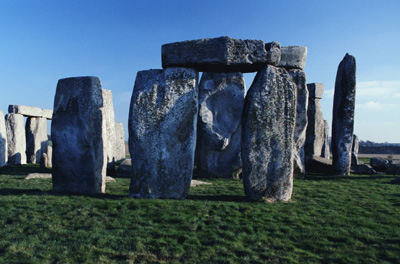Few monuments left by a vanished people are more impressive -- or more enigmatic -- than Stonehenge. Archaeologists speculate that the ring of immense stones on southern England's Salisbury Plain served as an observatory to mark the seasons and as a ceremonial center to celebrate the sun. Even today during the summer solstice, you can stand at the central Altar Stone and witness the sun rising precisely over the Heel Stone, located 250 feet away. Certainly, Stonehenge was a sacred place.
Famous Landmarks Image Gallery
Â
 ©Photodisc These massive stones were shaped by people of the Bronze Age using stone hammers the size of footballs. See more pictures of famous landmarks. |
Standing in the morning light like a portal to another world, the silhouetted trilithons -- the structures with two vertical stones supporting a horizontal stone laid on top -- only open a doorway to further questions. Who built this monument? And why?
Building began around 3000 B.C., when Neolithic people dug a circular ditch about 320 feet in diameter, using deer antlers as picks. In the second phase, about 2000 B.C., a double circle of at least 60 bluestones was erected. The stones came not from nearby quarries but from Wales, 240 miles away -- an amazing feat of water and overland transportation for Bronze Age people, especially because the stones weigh four tons apiece. Available transport probably included rafts, log rollers, and sledges. Over time, though, the circles were dismantled.
Stonehenge's third phase, a century later, created the arrangement of stones whose remains we see today. The stones, hauled 20 miles from the Marlborough Downs, weighed as much as 50 tons apiece. They were set upright in a circle and topped with a continuous ring of stone lintels. Inside was a horseshoe arrangement of other trilithons. Later some of the early bluestones were erected in a horseshoe inside.
The questions about Stonehenge remain. Despite mystical notions that the Druids built Stonehenge, these Celtic people didn't reach Britain until long after the last stone was put in place. "Most of what has been written about Stonehenge is nonsense or speculation," says one eminent British archaeologist. "No one will ever have a clue what its significance was."
Here are links to dozens of other world-famous landmarks:
| Abu Simbel, Egypt | Map of England ABOUT THE AUTHOR: Jerry Camarillo Dunn Jr., has worked with the National Geographic Society for more than 20 years, starting as a staff editor, writer, and columnist at Traveler magazine, then writing travel guides. His latest work is National Geographic Traveler: San Francisco. Dunn’s Smithsonian Guide to Historic America: The Rocky Mountain States has sold more than 100,000 copies. His travel pieces appear in newspapers such as the Chicago Tribune and The Boston Globe. Jerry Dunn's stories have won three Lowell Thomas Awards from the Society of American Travel Writers -- the highest honor in the field. He also wrote and hosted a pilot episode for a travel show produced by WGBH, Boston's public television station. Advertisement
Cite This!
Please copy/paste the following text to properly cite this HowStuffWorks.com article: Advertisement
Loading...
|